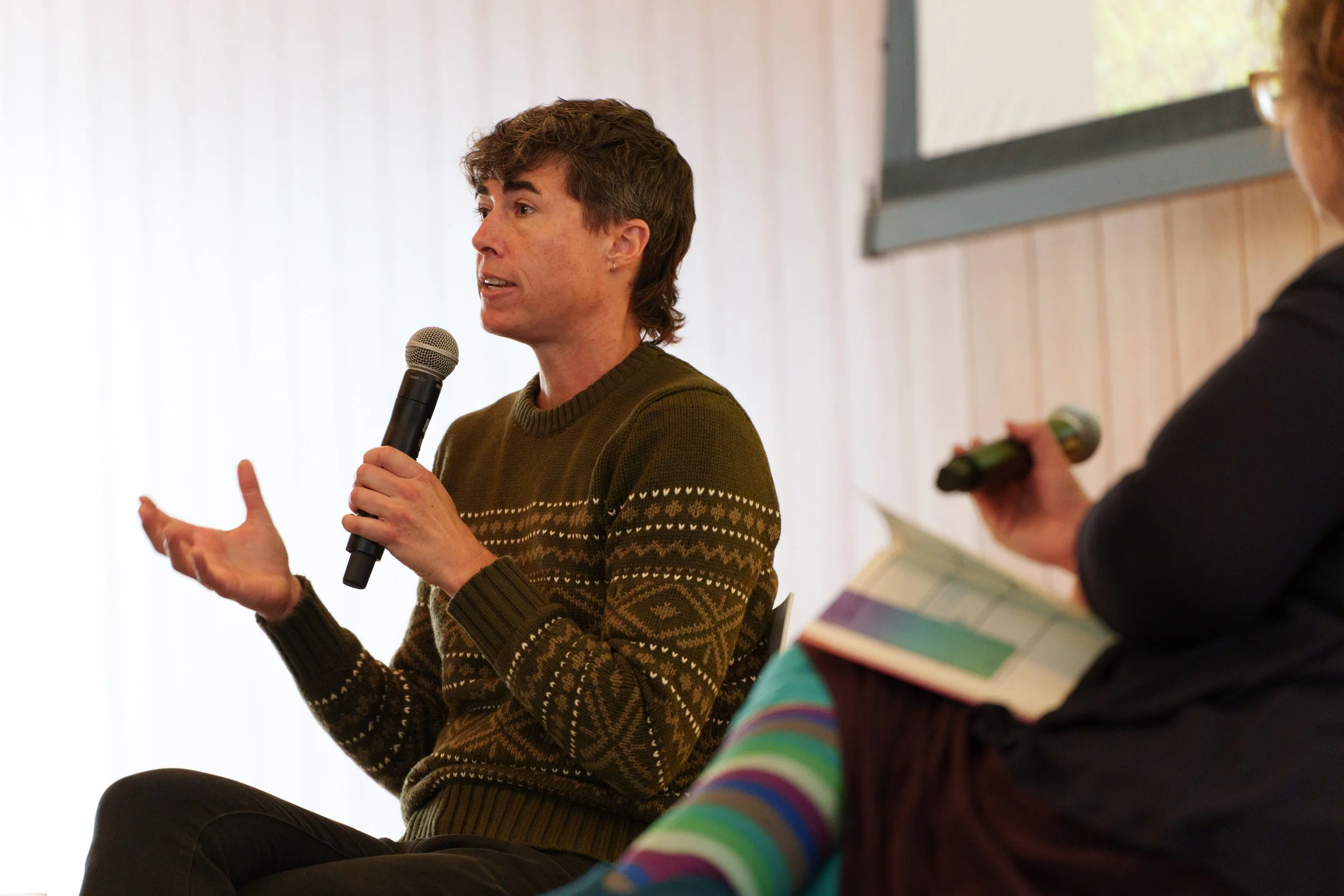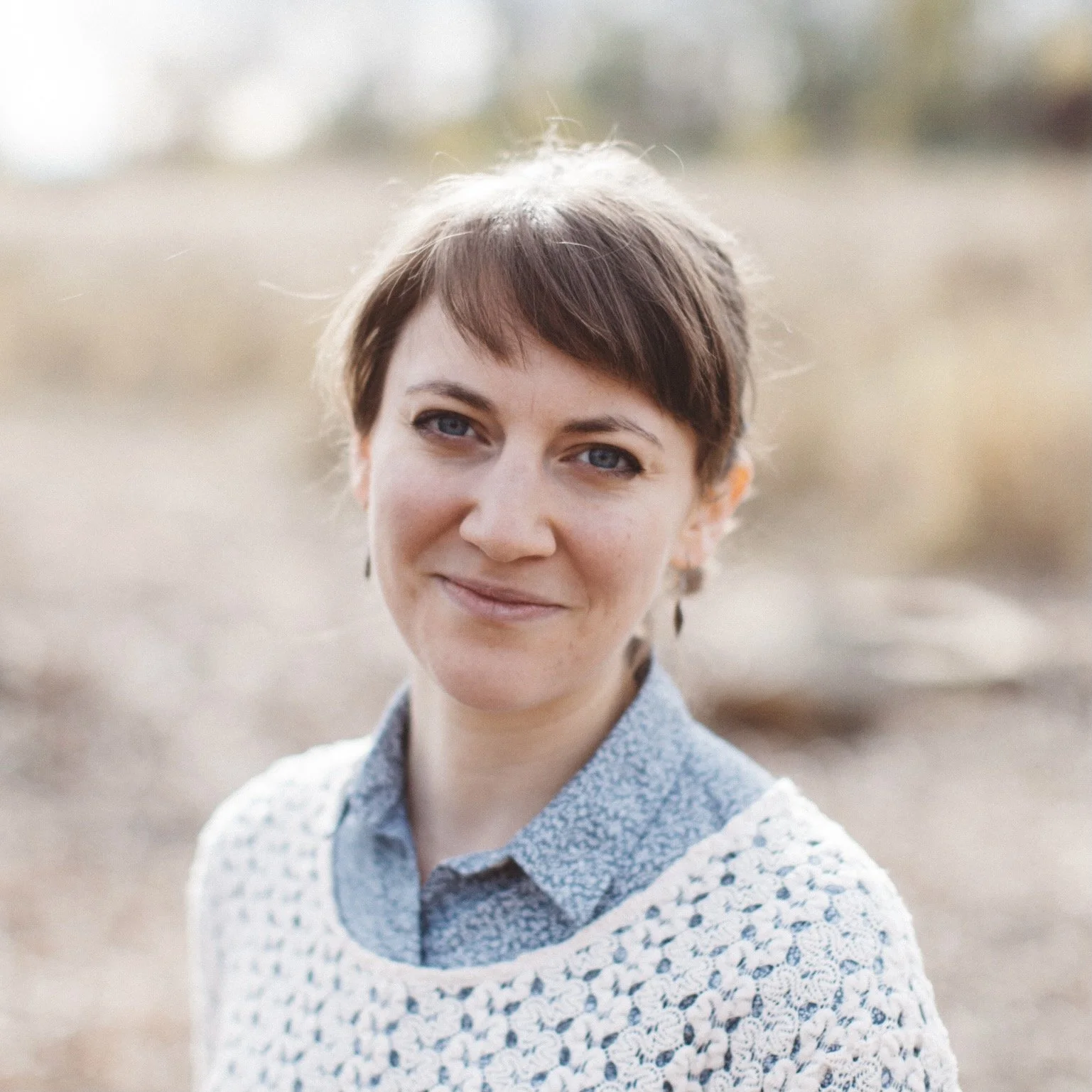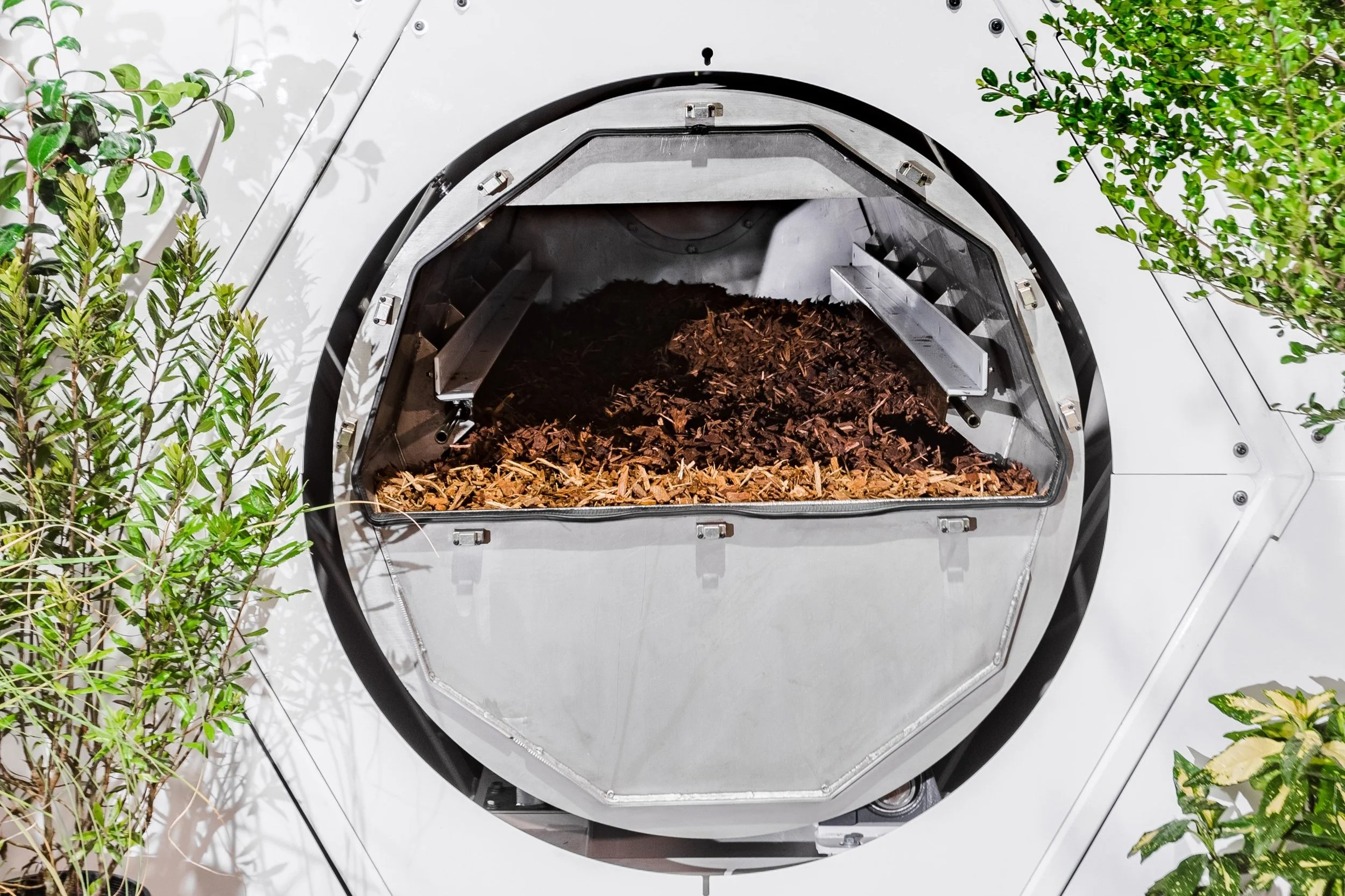By Amy Chatelaine
As part of its 2023 festival, The Great Northern presented a robust Climate Solutions Series at American Swedish Institute. Over three days, climate leaders gathered to discuss and offer diverse perspectives on climate solutions. We invited writer and event attendee Amy Chatelaine to have a conversation with one of the featured Series panelists, Katrina Spade—CEO of Recompose—to explore the concept of ecological death care further.

I didn’t know many entrepreneurs in my adolescence. At least not by the limited definition I was working with, which held firm boundaries around the world of business and capital. I can thank my studies in both the sciences and theology for eventually getting me to slow down and take a closer look at the word itself (a generative practice of both disciplines). Borrowed from the French verb entreprendre, “entrepreneur” most simply means to take between.
There it was: the gate in my tight boundary, with a question to lead the way out…
What if, at heart, entrepreneurship is the art and practice of leadership in liminal space?
I started seeing entrepreneurs in the most unexpected places.
When I learned at this year’s Great Northern Festival that there hasn’t been innovation in the American death care industry since the Civil War (you read that right), it came as no surprise — and actually, a great comfort — that the person and the practice of Katrina Spade is at the forefront of entrepreneurship in how we care for and honor our dead, specifically in urban America. And, how this is inextricably woven into how we care for and honor the earth by returning, quite literally, to the wisdom of the oldest cycles of life.

Katrina is the founder and CEO of Recompose and innovator in bringing the natural burial option to urban settings through the process of natural organic reduction, also known as human composting.
The origins of Recompose are rooted in a foundational question that animated Katrina from the beginning of her formal study of architecture and design: What is nature?
Spade: I started to think about how we usually think about nature, which is mostly trees and plants, what’s green and growing. But what’s underneath those trees and plants is actually the basis of all nature, which is soil. It sounds so obvious when I say it, but also so overlooked.
So then I thought, what would it mean to actually contribute to the creation of new soil in cities? That felt pretty powerful. And then the dream was — we live in our cities, we love our cities; what if we could be folded back into the city, not taken to somewhere else after we die?
As I sat in a room filled to capacity for Katrina’s session of the Climate Solution Series, I was moved by a story she shared of Wayne, who chose Recompose for his death care. Wayne had a love for gardening with his neighbors, and his soil now enriches his local community in Seattle:
Spade: Wayne’s soil was folded back into his neighborhood in the city, into the lives of his neighbors. He will become both the beautiful Japanese maples that his sister planted and also what grows in the parking strip where they spread his soil.
I spoke with Katrina afterwards, and had the pleasure of drawing out the essence of her entrepreneurial ethos that touches every aspect of Recompose: from the design of their space to the design of a workplace culture that seeks to inform, comfort, and inspire towards wellbeing and wholeness.

Chatelaine: In many people’s imagination, there tends to be an association of “nature” with wilderness or rural landscapes. And part of your work is to bring urban spaces into that imagination, and this option of death care as part of it — what have you noticed in the people who choose to work with Recompose?
Spade: There’s an interesting balance. Half of our families donate the soil to this forest [Bells Mountain], because for many people, they need that connection to wilderness. Then there are people whose soil is taken back into the city, like Wayne. That’s also beautiful.
And there’s a paradox, I suppose you’d call it. Recompose is located in an industrial zone in Seattle. So folks drive down this street filled with big trucks, and off in the distance is this massive, awesome wall of shipping containers, right on the Duwamish River. But when you pull up [to Recompose], you know you’ve arrived. We focused very hard on that design-wise, because we wanted to make sure that we immediately comforted people in knowing that they arrived at the right place. We have this huge soil mural on the building, and then when you walk into the lobby, there are images of the forest on the wall, and it’s calm and really quiet compared to outside. Do I wish it was more bucolic? Sometimes, but I kind of love that it’s this really industrial place — we need this warehouse, because we’re making compost. So it’s a tension, practically speaking, and also really interesting to do the work in the city because of that.
Chatelaine: I noticed in the images of the Gathering Space, there’s stained glass and other elements that look similar to or evocative of, at least in some religious traditions, what a celebration of life service would be. So people enter with these cues that they are in a sacred space, or a space where their loved one will be held with reverence and care, while holding that tension you named.
Spade: Yeah, that reverence piece. We worked with an architect in Seattle, Olson Kundig, especially on that gathering space. It is a very clear nod to a chapel with stained glass, and we wanted to evoke the light filtering in through the forest. So we actually have light that comes through from the greenhouse, where we’re composting, also nodding to that room as sacred. And the people that are doing that work — the operators tending the vessels — they consider it sacred work. And also, it’s industrial work. And it’s dirty work.
Whether you donate the soil or take it with you, we give you a small box of it when the process is complete. And that soil can have meaning for you; it’s going to go grow something. But also, it’s okay to let go of a feeling that this is so meaningful — a feeling that can be restrictive. The box itself, we made sure to design as something that you would compost. It’s blank cardboard, wrapped with something that, I think, makes it a lovely container, but not a precious container. We wanted people to receive it and not have to wonder, should I keep this forever?

Chatelaine: You can let it go.
Spade: You can let it go. Plant it! Plant the soil. Compost the box. I just think that holding those things together is so fascinating — being able to embrace something as sacred and also totally just dirt.
Chatelaine: This is really opening up a place for rich theological conversation. And, I wonder, from the perspective of spiritual care, what this model of death care might offer to our practices around accompanying grief?
Spade: Something that is said in the more alternative death care community is that death is not an emergency. That I love so much. When someone dies, the emergency has happened. So when someone calls us, the first thing we do is work with the family to know they can take some time. It is great that you’ve called, but we don’t have to come pick the body up right away. So that just begins setting the tone, I think, of space and time. If you’ve ever been at the birth of a child, and time just slows and expands — this same thing happens during a death and after a death. You’re in this time that no one else is in, where you just totally step out of the flow of normal life.
The other thing that is interesting about time is our Recompose people work with families for two to four months. Which is very unusual; think of a conventional funeral experience. Often we get a pre-death call that a person is going to die, and we have some conversations then. And then after the person dies, they get transported to us. Sometimes it takes a little time if they decide to do a service before that, like a week or two. Then the [natural organic reduction] process takes one to two months. The soil is being created, and then on the other side, the family comes. And we’re communicating with them the whole time. In a way, there’s kind of a sustainable flow in both processes — the bereavement and the creation of soil. It’s very cool.
Chatelaine: As I prepared to speak with you, I listened to your interview with Erin Axelrod in Next Economy Now. You spoke about how one of your technical design challenges is figuring out the environment that “helps nature do its thing” best, in terms of organic reduction. I was really impressed and inspired to hear how you’re also taking this on as it relates to your workplace environment, and the care of the people doing this work. What are some of the practices or principles that your team holds with each other to create such an environment?
>
“We have three main “pillars,” if you will: inform, comfort, and inspire — that go with any messaging we do from a phone call to someone, to a blog piece, to anything we’re trying to make — we can comfort people through informing and offering clarity, and then maybe we’re inspiring folks along the way, too. ”
Spade: Well first, there’s a lot of burnout in the funeral industry in general and not a lot of attention paid to boundaries with work or self-care. And so one of the things we did together across departments is put together an emotional care training that everyone who joins Recompose takes. It goes through what we do here — what might it feel like? And what does it mean to care for people whose grief is not yours? Early on we had folks join us that hadn’t worked in death care, and so every death felt like they needed to 100% own another person’s or family’s grief. And I was like, this is not sustainable, this won’t do. I do love that we can hire people from outside of death care. But that also takes a certain amount of training, and is something our team talks about a lot — what we’re trying to do is give and create boundaries and make sure that people can then espouse them and know that they’re theirs.
We have three main “pillars,” if you will: inform, comfort, and inspire — that go with any messaging we do from a phone call to someone, to a blog piece, to anything we’re trying to make — we can comfort people through informing and offering clarity, and then maybe we’re inspiring folks along the way, too. So those are the three things that we work on externally, and we’re also working on what is our internal, similar kind of ethos.
A few days after speaking with Katrina, I attended another session of the Climate Solution Series with the biologist and innovation consultant Janine Benyus. Janine works with designers and engineers in the scientific practice of biomimicry, which she defines as “the conscious emulation of life’s genius.”
I’ve been thinking about this definition ever since this year’s festival, alongside a reminder — and I would offer, an invitation — held within Katrina’s reflection on her unexpected entry into the space between architecture and death care, which is, for me, an unexpected and most welcome contributor to climate solutions:
Spade: I just had this idea, I think, that architecture and design was so far off in the distance. And then I started to realize how everyone — you wake up every morning, and you’re a designer. Like, you have your house a certain way. All of us — sometimes intentionally, sometimes less so — are creating.
May we all enter the fertile, middle-spaces of our industries and relationships with such consciousness, reverence, and emulation for the creative genius in life processes often overlooked — even those right beneath our feet.

Amy Chatelaine, MDiv provides spiritual and creative accompaniment at the intersections of health, theology, public media, and the arts. Over a decade ago, a yearlong internship in hospice care for the unhoused in Washington, DC led her into an early career in public health, and later to study at Emory University’s Candler School of Theology. Woven throughout her life and work is a commitment to nurturing vitality in transitions — from the scale of individual to organizational, through the practice of courage, compassion, and joy. Amy grew up across a spacious vista of farmland in southeastern Minnesota. An avid explorer, this landscape will always be her first language. Music is another, which she voices through the cello. She is the child of teachers, the sibling of ministers, and aunt to her kindred spirits in curiosity and delight. Amy lives in the Twin Cities and works at The On Being Project.

